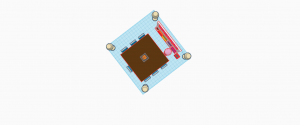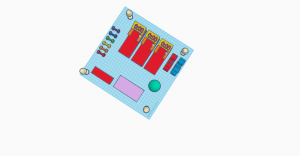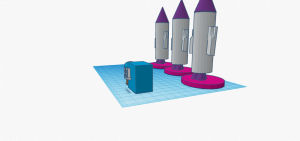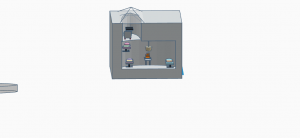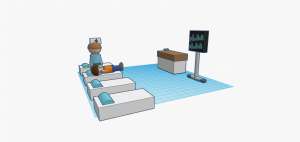Moon Camp Explorers Gallery 2020-2021
In Moon Camp Explorers each team’s mission is to 3D design a complete Moon Camp using Tinkercad. They also have to explain how they will use local resources, protect astronauts from the dangerous of space and describe the living and working facilities.
Team: ??✨Lunar Campers✨??
Jack Miner Public School Whitby Canada 10, 9
External link for 3d
|
Project description
Our MoonCamp is called Valentina, after Valentina Tereshkova, the first woman in space. We thought this name would be fitting because the Artemis mission is planning to put the first women on the moon. As young women, and budding scientists, we are inspired by her, and we really look forward to more missions with women astronauts. We’ll have Kindles, not books because they are lighter and more compact. .They’ll also provide much needed entertainment for our astronauts on the moon. We’ll bring soil to start our farm. The part of the crops the astronauts can’t eat will go into compost which can be turned into fertilizer. We will grow al-soy (which is an almond soy cross breed) as well as other crops to eat. Our astronauts will regularly clean our MoonCamp since dust would build up everywhere on the moon, and you can’t open a window, since it would result in loss of oxygen. Our robot, Lunar, will help with the clean-up. It’ll also help with water fertilization and growing plants. Our astronauts pee will be filtered into clean water and their poo will be used as fertilizer for our plants. So our MoonCamp will be largely self-sufficient. |
|||
|
Where do you want to build your Moon Camp?
The Rozhdestvenskiy crater Why did you choose this location?
We are choosing this place to live because people underground are less prone to get radiation poisoning and/or being crushed by meteorites. Also, the temperature is much warmer for the moon’s climate. (still pretty cold to humans). How do you plan to build your Moon Camp? Which materials would you use?
We’ll use shatter-proof glass for above ground locations and for underground locations we’ll use plastic. For the greenhouse we’ll have more shatter-proof glass and have some shades rolling in 16 hours a day so the plants will have 8 hours of sunlight. We’ll also have a solar panel attached to a building with lots of Lithium-Ion batteries to get solar energy for 14 days where there is no sunlight. We’ll use the solar energy conserved for artificial light to act like sunlight. We’ll transport everything from Earth and bring a super large 3D Printer to make buildings out of regolith. Explain how your Moon Camp will provide the astronauts with:
|
|||
|
Water
|
Food
|
Electricity
|
Air
|
|
We’ll use heated drills to mine through the moon’s surface for water. In the middle of drilling sections there will be coconut trees and cactuses, all plants which bear water. We’ll have an astronaut training program in which they’ll have to survive in a desert with only the amount of water that they can fit on the spaceship with their weight-budget. This will help them train for the lack of water on the moon. They’ll also have to learn to heat ice before drinking because if you eat the ice it will use water to digest, giving back little water. |
We will bring some provisions from Earth and farm foods through strategies like aquaponics, which will provide us with not only plants but also fish which can be eaten for extra meat fats and also can be used as fertilizer when they die. Since the foods that provide the most calories are all cheese products, we are growing an al-soy (almond soy)cross breed to extract the milk from and make vegan cheese so we don’t need a cow or any other mammal. For plants that can’t be grown using aquaponics, We’ll fertilize it with the fish and astronaut feces. |
We’ll get power from batteries that’ll be empty, but will be filled with solar power on the Moon. The power will be stored in stations that will be close to our camp. We’ll use solar panels on top of our greenhouse |
We’ll have Aloe Vera and other plants in a greenhouse which is connected to an oxygen storage facility which goes through vents to get to places around our camp. We’ll also use algae like spirulina to coat the walls of our habitat. We’ll have hanging pots filled with Aloe Vera in the bedroom and the curfew will be early because other plants ingest oxygen in the night. You could only spend 1 hour at a time there because pure oxygen would kill you. That’s why other than all of this, our main source of oxygen would be water electrolysis. |
|
Describe a day on the Moon for one of your Moon Camp astronauts
Imagine living in the Moon. That wasn’t a typo. I meant in not on. In our SpaceCamp the primary living space is below ground in the Rozhdestvenskiy crater. I wake up at 5 o’clock sharp, I brush my teeth, take a 1-minute towel shower, put new clothes on, and go downstairs to the mess hall to eat breakfast. I have an hour to prepare my food and eat it. For breakfast we have salad and al-soy milk with cheese on the side. The crew and I then head to the main deck and have 30 minutes for the brief. Our resident botanist heads to the greenhouse to harvest crops and tend to the plants. Our technician monitors the control room, and the captain contacts Earth. I, as a biologist, perform crew check-ins. At 10:00 GMT, we meet in the gym and exercise for 1 hour and 30 minutes. For lunch we have salmon with clover and al-soy cheese. After lunch, it’s time for a moonwalk. Short on our water supply, I and our technician head to our heated drill and start mining at the surface of the moon. I spend some time in the lab to experiment with plant cross-breeds. Then we have free time hanging out in the lounge or resting in our bedroom. At 7:30 we go to dinner. We have sandwiches, al-soy milk and vegetable soup. After dinner we spend 2 hours cleaning and then finally go to sleep, preparing for the next Moon day. |
|||





